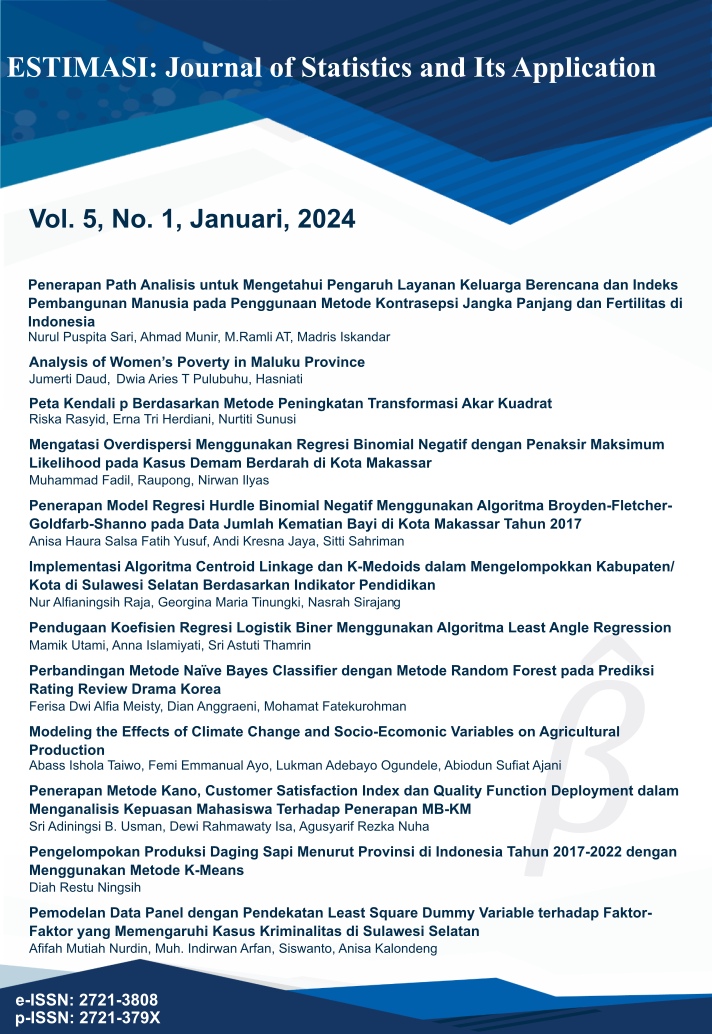Penerapan Path Analisis untuk Mengetahui Pengaruh Layanan Keluarga Berencana dan Indeks Pembangunan Manusia pada Penggunaan Metode Kontrasepsi Jangka Panjang dan Fertilitas di Indonesia
Article History
Submited : October 15, 2023
Published : January 29, 2024
The efficacy of nationwide population control initiatives in Indonesia ought to be uniformly dispersed throughout all provinces. The decentralization policies implemented by each local government and regional differences in characteristics have, nevertheless, resulted in substantial discrepancies in TFR across all provinces in Indonesia. The efficacy of long-acting contraceptives is widely acknowledged as the primary prerequisite for mitigating the pace of population growth. In addition to reducing the TFR, the government has established goals for the equitable distribution of family planning programs across Indonesia. The implementation of family planning programs in an equitable manner will impact the birth rate reduction. The objective of this research is to examine the potential impact of contextual elements on fertility reduction via contraceptive methods in Indonesia. The findings of this research indicate that the proportion of women utilizing long-acting contraceptive methods has the most significant impact on TFR reduction in Indonesia, at -0.562. In contrast, the HDI and the number of family planning villages each have an influence of -0.12 and -0.36, respectively, on TFR reduction.
References
- Hull, T. Indonesia’s Fertility Levels, Trends And Determinants: Dilemmas Of Analysis. Pp. 133–151, 2016, doi: 10.1007/978-3-319-24783-0_8.
- United Nations. Department Of Economic And Social Affairs, World Social Report 2020 : Inequality In A Rapidly Changing World. 2020.
- Freedman, R., & Sumanto, N. B. Theories Of Fertility Decline : A Reappraisal. (1983). Teori-Teori Penurunan Fertilitas : Suatu Tinjauan / Ronald Freedman ; Diterjemahkan Oleh Nin Bakdi Sumanto. Yogyakarta: Pusat Penelitian Dan Study Kependudukan Universitas Gajah Mada, 1983.
- Statistic of Indonesia, Hasil Long Form Sensus Penduduk 2020. 2020, Accessed: Aug. 22, 2023. [Online]. Available: Https://Www.Bps.Go.Id
- BKKBN, BPS, & Kemenkes RI, Survei Kinerja Dan Akuntabilitas Program Kkbpk (Skap) Keluarga. 2018.
- Khatimah, H., Astuti, Y. L., & Yuliani, V. Determinan Penggunaan Metode Kontrasepsi Jangka Panjang Di Indonesia (Analisis Sdki 2017). Insologi: Jurnal Sains Dan Teknologi, 1(2), Pp. 117–126, 2022, Doi: 10.55123/Insologi.V1i2.249.
- BKKBN. Survei Kinerja Dan Akuntabilitas Program Kkbpk (Skap) Keluarga. 2019.
- Pachauri, S., & Santhya, K. G., Reproductive Choices For Asian Adolescents: A Focus On Contraceptive Behavior. Int Fam Plan Perspect, 28(4), 186, 2002, doi: 10.2307/3088221.
- Aduloju, O. P., Akintayo, A. A., Adefisan, A. S., & Aduloju, T. Utilization Of Long-Acting Reversible Contraceptive (Larc) Methods In A Tertiary Hospital In Southwestern Nigeria: A Mixed Methods Study. The Journal Of Obstetrics And Gynecology of India, 71(2), Pp. 173–180, 2021, doi: 10.1007/S13224-020-01386-6.
- Yuliati, I. Peramalan Dan Analisis Hubungan Faktor Penggerakan Lini Lapangan Dalam Meningkatkan Peserta Kb Aktif Mkjp. 2021.
- Bahamondes, L., Fernandes, A., Monteiro, I., & Bahamondes, M. V. Long-Acting Reversible Contraceptive (Larcs) Methods. Best Pract Res Clin Obstet Gynaecol, 66, Pp. 28–40, 2020, doi: Https://Doi.Org/10.1016/J.Bpobgyn.2019.12.002.
- Purwaningsih, N., Gresty, S., Rina, M., & Kedokteran, F. Penggunaan Metode Kontrasepsi Pada Wanita Usia Subur Dengan Siklus Menstruasi Di Puskesmas. 2019.
- Nurjaeni, N., Sawangdee, Y., Pattaravanich, U., Holumyong, C., & Chamratrithirong, A. Quality Of Family Planning Care As Enabling Factor For Modern Contraceptive Use In Indonesia: Evidence From Pma2020 Survey. doi: 10.21203/Rs.3.Rs-516964/V1.
- Taebenu, M. M. Stalled Fertility Decline In East Nusa Tenggara, Indonesia, 2002-2017: Understanding Its Determinants. Jurnal Kependudukan Indonesia, 15(2), P. 227, 2021, doi: 10.14203/Jki.V15i2.504.
- Budiarty, S. Analysis Of The Participation Of Couples Of Reproductive Age In Family Planning Program In South Sulawesi. 2022.
- Gayatri, M. Kependudukan, B., Keluarga, D., & Nasional, B. Analisis Pemakaian Kontrasepsi Di Wilayah Miskin Perkotaan Di Indonesia. 2022, Doi: 10.37306/Kkb.V7i1.
- Babazadeh, S., Anglewicz, P., Wisniewski, J. M., Kayembe, P. K., Hernandez, J., & Bertrand, J. T. The Influence Of Health Facility-Level Access Measures On Modern Contraceptive Use In Kinshasa, Drc. Plos One, 15(7), P. E0236018, 2020, doi: 10.1371/Journal.Pone.0236018.
- Yolanda, A. M., & Yunitaningtyas, K., & Widya K. B. K. Segmentasi Provinsi Berdasarkan Sarana Dan Perlengkapan Fasilitas Kesehatan Keluarga Berencana Tahun 2021. 2021.
- Stage, F. K., Carter, H. C. & Nora, A. Path Analysis: An Introduction And Analysis Of A Decade Of Research. J Educ Res, 98(1), Pp. 5–13, 2004, doi: 10.3200/Joer.98.1.5-13.
- Putra, A. N., Tobing, H. F. B., Rahajeng, O. S., & Yuhan, R. J., Penerapan Path Analysis Terhadap Faktor-Faktor Yang Mempengaruhi Ipm Dan Kemiskinan Di Indonesia Tahun 2019. The Indonesian Journal Of Social Studies, 3(1), P. 37, 2020, doi: 10.26740/Ijss.V3n1.P37-45.
Downloads
Download data is not yet available.
Fulltext
